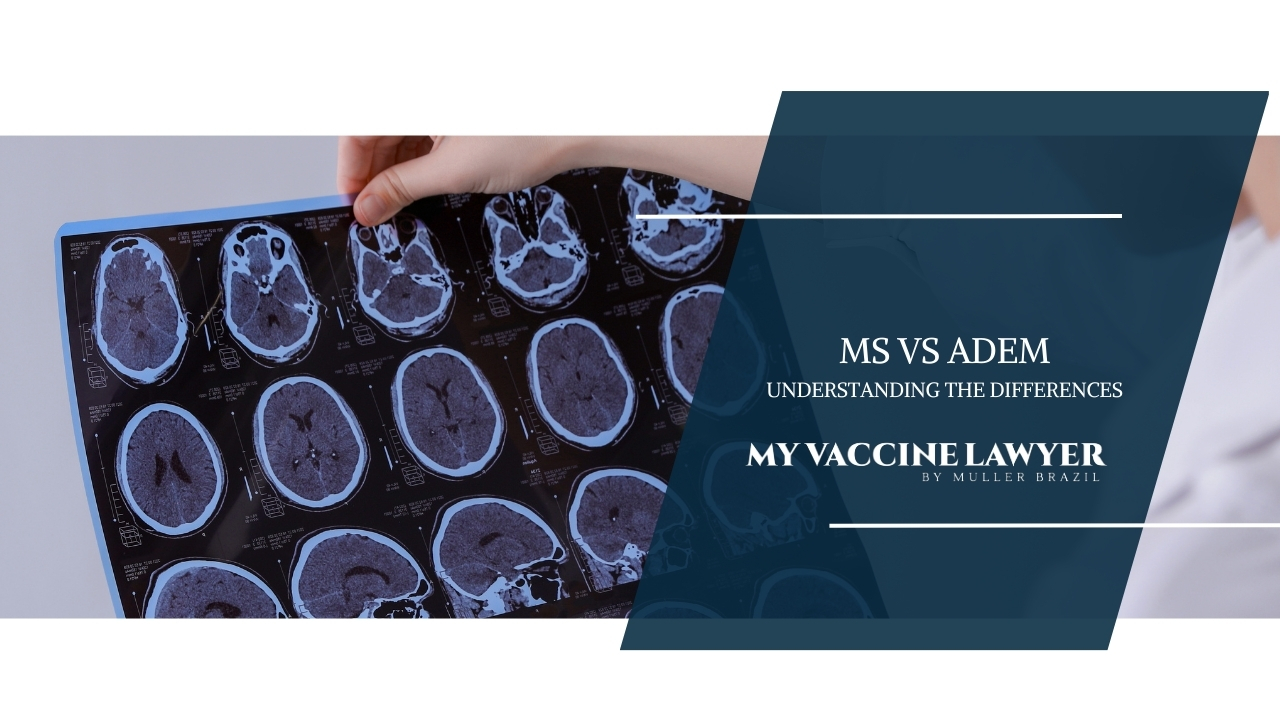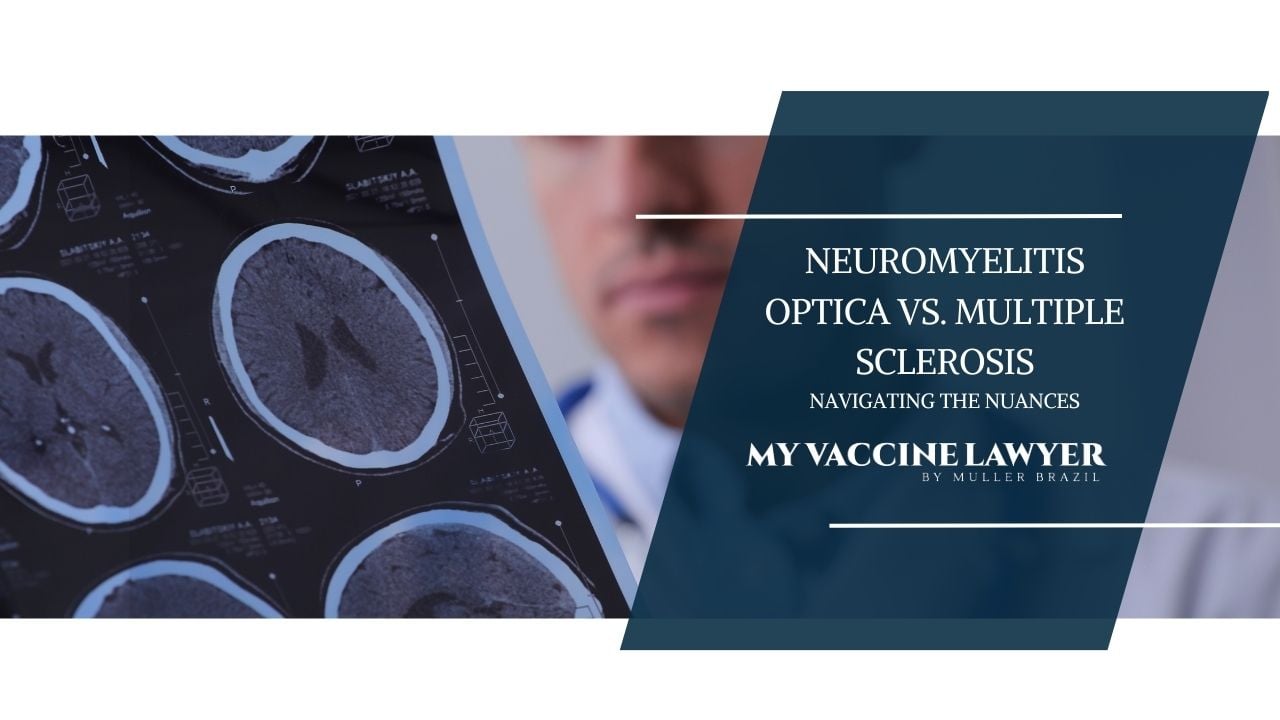9 min read
ADEM vs. MS: Key Differences and Diagnostic Insights
Vaccine Injury Law Resources / Vaccines / ADEM vs. MS: Key Differences and Diagnostic Insights
 Max Muller
:
Jul 9, 2024 9:47:11 PM
Max Muller
:
Jul 9, 2024 9:47:11 PM
When faced with neurological symptoms, distinguishing between ADEM and MS can be of utmost importance for appropriate treatment and management.
ADEM is sometimes misdiagnosed as a severe first attack of MS since some of the symptoms of the two disorders may be similar. However, ADEM usually — but not always — consists of a single episode or attack lasting weeks or months, while MS features many attacks over time.
ADEM, a rare inflammatory condition often precipitated by infection, tends to affect children and usually resolves with treatment, whereas MS, a chronic autoimmune disease, primarily affects young adults and often requires lifelong management.
This article zeroes in on the essential differences and diagnostic cues between ADEM vs MS to provide clarity for patients, caregivers, and healthcare professionals alike.
Key Takeaways
- ADEM is a rare, inflammatory demyelinating disease primarily affecting children and often triggered by infections, while MS is a chronic autoimmune disorder that affects young adults with symptoms that progress over time.
- Diagnosing ADEM or MS involves a detailed medical history, neurological examinations, MRI scans, and tests such as cerebrospinal fluid analysis and blood tests for MOG antibodies, which can differentiate the two conditions.
- Treatment for ADEM focuses on promptly halting brain inflammation and often leads to significant recovery without long-term medication, whereas MS management includes long-term disease-modifying therapies, symptom control, and rehabilitation.
Understanding ADEM and MS
ADEM and MS are distinct yet similar conditions. Acute disseminated encephalomyelitis adem is a rare disease that mainly affects children under the age of 10. It involves an immune system overreaction that causes inflammation and damages the myelin sheath, a protective layer around the brain and spinal cord nerve fibers.
This event, often referred to as acute CNS inflammatory demyelination, typically presents as a solitary immune response, often triggered by recent bacterial or viral infections. When acute disseminated encephalomyelitis is diagnosed, it is crucial to start appropriate treatment as soon as possible.
Alternatively, multiple sclerosis, or MS, is a chronic autoimmune disorder that predominantly impacts young adults. The body’s immune system mistakenly attacks the central nervous system, leading to inflammation and the stripping of nerves’ myelin coating. The etiology of MS is believed to involve a combination of genetic predisposition and an external trigger, possibly viral or environmental.
ADEM Overview
ADEM primarily impacts children, especially those under the age of 10, with an estimated occurrence rate of 0.8 cases per 100,000 population per year. Boys are more commonly affected than girls, and the incidence is higher during the winter and spring months.
ADEM is frequently triggered by a recent bacterial or viral infection, such as upper respiratory tract infections or a sore throat. In rare cases, vaccination can also precede the development of ADEM. The immune response in ADEM targets myelin basic protein, leading to demyelination.
The typical MRI scan for a patient diagnosed with ADEM reveals:
- Multiple hyperintense lesions in T2-weighted, non-contrast FLAIR, and PD MR imaging scans
- The lesions may be large and confluent, occupying almost all of the white matter
- Smaller lesions resembling those of MS are common
These scan results help differentiate ADEM from MS, as ADEM brain MRI results typically indicate minimal progression over time.
MS Overview
MS is a lifelong neurological disorder with causes that are not fully understood. The etiology of MS is believed to involve a combination of genetic predisposition and an external trigger, possibly viral or environmental. Clinically isolated syndrome (CIS) is an initial neurological episode that may be indicative of MS, but not all CIS cases progress to MS.
MRI scans can reveal progressive damage over time, which is more typical of MS. Lesions in MS indicate ongoing disease activity and appear as bright spots revealing demyelination.
The progression of distinct symptoms can be subtle and occur over an extended period of time, especially in cases of primary-progressive MS, where symptoms may gradually worsen without clear relapses or remissions.
A study conducted in 2017 estimated that nearly 1 million adults in the United States are living with MS.
Comparing Symptoms of ADEM and MS
While ADEM and MS share some symptoms, they also have unique symptoms that help differentiate between the two conditions. ADEM and MS include:
- vision problems
- fatigue
- body weakness
- numbness
- cognitive changes
However, distinguishing symptoms that differentiate ADEM from MS include confusion and fever, which are typically not observed in MS. These symptoms can help in diagnosing acute disseminated encephalomyelitis.
Further, MRI scans are pivotal in distinguishing ADEM from MS as they can identify unique lesion patterns and reveal the progressive damage over time that is characteristic of MS. The clinical presentation of these symptoms and MRI prognostic factors can help determine the course of the disease and contribute to a more accurate clinical diagnosis.
Common Symptoms
ADEM and MS patients may encounter vision problems. The diagnosis of ADEM and MS typically involves:
- A comprehensive review of the patient’s medical history
- Thorough physical and neurological examinations
- The administration of specific tests aimed at excluding other potential conditions.
Fatigue is a common symptom and presents as a significant depletion of mental and/or physical energy, which may stem from the neurological disease process or other related factors. Individuals diagnosed with ADEM commonly encounter widespread bodily weakness, whereas individuals with MS may experience paresthesia, characterized by prickling and tingling sensations typically felt in the hands or feet.
Numbness in patients with ADEM and MS typically presents as a loss of sensation in the limbs, impacting their ability to perceive touch, temperature, and pain.
Unique Symptoms
ADEM presents with additional symptoms such as:
- fever
- seizures
- vomiting
- headache
- confusion
Encephalopathy in patients with ADEM presents as an acute-onset manifestation accompanied by polyfocal neurologic deficits and is usually self-limiting. Among the patients with ADEM, 10 out of 24 were found to have encephalopathy, while no patients in the MS group exhibited encephalopathy. This highlights the presence of adem symptoms in these patients.
In contrast, the progression of MS symptoms is typically gradual. MS symptoms typically deteriorate gradually as time passes. Particularly in cases of primary-progressive MS, symptoms may gradually worsen without clear relapses or remissions.
Diagnosing ADEM and MS
Diagnosing ADEM and MS requires following the diagnostic criteria, which include:
- A detailed review of the patient’s medical history
- Complete physical and neurological examinations
- The execution of specific tests to rule out other possible conditions
- MRI scans
- Cerebrospinal fluid analysis
These tests play a significant role in differentiating between ADEM and MS.
Supplementary examinations for distinguishing ADEM from MS may include blood tests for MOG antibodies, which are more common in ADEM patients, and evaluations of cellular adhesion patterns that can vary between the two disorders.
MRI Scans
MRI scans are instrumental in distinguishing ADEM from MS due to their ability to identify unique lesion patterns and display progressive damage over time, more indicative of MS. The typical MRI scan for a patient diagnosed with ADEM reveals multiple hyperintense lesions in T2-weighted, non-contrast FLAIR, and PD MR imaging scans. These scans help differentiate ADEM from MS, as ADEM brain MRI results typically indicate minimal progression over time.
In contrast, lesions in MS indicate ongoing disease activity and appear as bright spots revealing demyelination. The progression of distinct symptoms can be subtle and occur over an extended period of time, especially in cases of primary-progressive MS, where symptoms may gradually worsen without clear relapses or remissions.
Cerebrospinal Fluid Analysis
The cerebrospinal fluid analysis serves as a valuable tool in distinguishing between ADEM and MS by providing additional information, such as the presence of oligoclonal bands, which are typically found in MS patients. The process of cerebrospinal fluid analysis includes obtaining a sample of the spinal fluid that envelops the brain and spinal cord and then conducting a series of tests to identify diseases affecting the brain and spinal cord.
Oligoclonal bands are significant for the diagnosis of MS as their presence in cerebrospinal fluid indicates inflammation in the central nervous system, which is a characteristic feature of MS. The primary distinctions in cerebrospinal fluid findings include the presence of oligoclonal bands, which are more frequently detected in individuals with MS, and an elevated IgG index that is also indicative of MS.
Additional Tests
Additional tests may include blood tests for MOG antibodies, which are more common in ADEM patients, and cellular bonding patterns that differ between ADEM and MS patients. MOG antibodies are linked to ADEM, as a recent study found that 40% of ADEM patients tested positive for MOG antibodies. The presence of MOG antibodies can aid in the differentiation of ADEM from MS.
The cellular bonding patterns, which involve the bonding to a wide variety of antigens, are more commonly observed in patients diagnosed with ADEM compared to those with MS. These additional tests, along with MRI scans and cerebrospinal fluid analysis, help physicians accurately diagnose these conditions and initiate appropriate treatment plans.
Treatment Options for ADEM and MS
Therapeutic approaches for ADEM and MS differ. ADEM treatments are geared towards halting brain inflammation, while MS therapies aim to manage symptoms and decelerate disease progression. ADEM treatment primarily centers on:
- Administration of high doses of glucocorticoids
- Immunoglobulin therapy
- Plasmapheresis
- Symptom management
These treatments help halt brain inflammation and often lead to patient recovery without the necessity of long-term medications.
Conversely, MS treatments encompass:
- Disease-modifying therapies
- Diverse symptom management methods
- Rehabilitation to improve quality of life while trying to decelerate the advancement of the disease.
ADEM Treatments
The goal of the treatment for ADEM is to stop the inflammation in the brain and reduce the impact of the condition on the patient’s health. The following treatments are commonly used:
- Intravenous and oral corticosteroids: These medications help reduce inflammation.
- Intravenous immunoglobulin therapy: This treatment helps control the autoimmune response that leads to damage of the myelin sheath.
- Plasmapheresis: This procedure removes harmful antibodies from the blood.
Long-term medications are generally not required once ADEM is under control. Most people with ADEM improve significantly or recover completely within weeks to a few months. However, in severe cases, ADEM can lead to fatality, particularly when accompanied by brain swelling or respiratory difficulties.
Take Control of Your Injury Today
MS Treatments
Treatment for MS is more long-term and involves:
- Disease-modifying therapies are designed to impede the progression of the disease. Recent advancements in this field include the approval of OCREVUS® as the primary approved treatment for primary-progressive MS and the investigation of Bruton’s tyrosine kinase (BTK) inhibitor for relapsing-remitting MS.
- Symptom management methods
- Rehabilitation
Symptom management in MS treatment encompasses:
- Physical therapy
- Aerobic exercises
- The use of assistive devices
- 4-aminopyridine for addressing fatigue and temperature-related weakness
- Pain management through the administration of anticonvulsant medications.
Rehabilitation in the context of multiple sclerosis is centered on the improvement or preservation of functions, the prevention of complications, and the overall improvement of the patient’s quality of life.
The economic impact of MS is substantial. In 2019, the overall estimated economic cost of MS was approximately $85.3 billion
Prognosis and Long-Term Outcomes
The outlook and long-term consequences for ADEM and MS patients vary considerably. ADEM patients generally have a more favorable prognosis, with most achieving a full recovery. However, a small portion may face long-term impairments or, in rare instances, mortality.
In the case of MS patients, the prognosis can vary significantly, with some experiencing mild symptoms and others encountering substantial disability and a shortened lifespan. Following recovery, ADEM patients may encounter a variety of potential impairments, such as:
- cognitive difficulties
- muscle weakness
- vision damage
- numbness
On the other hand, individuals with multiple sclerosis generally have a life expectancy that is approximately seven years shorter than that of the general population.
Additionally, the quality of life can be notably affected, often leading to substantial disability and persistent health difficulties.
ADEM Prognosis
ADEM typically has a favorable prognosis, with most patients recovering completely, though a small portion may suffer from long-term impairments or, in rare instances, death. The recovery process typically commences within a few days, and the majority of individuals achieve complete recovery within six months. The prognosis of ADEM can be influenced by various factors, including:
- previous infection
- genetics
- exposure to infectious organisms
- immunization
Recurrence can occur in ADEM patients, with varying rates reported in different studies, typically within the first 2 years after initial presentation. In rare, severe cases, ADEM can lead to fatality, particularly when accompanied by brain swelling or respiratory difficulties. Despite these risks, the majority of individuals diagnosed with ADEM tend to have a normal life expectancy, given that the condition is rarely life-threatening.
Call Us Now
MS Prognosis
The outlook for MS is highly variable, with some patients only experiencing mild symptoms and others contending with substantial disability and a shorter lifespan. The outlook for MS is affected by a combination of factors, including:
- Psychiatric comorbidities
- Vascular disease co-morbidities
- Sex
- Age
- Course of disease
- Treatment received
- Lifestyle factors
- Biological, disease-related, and demographic factors
Individuals diagnosed with MS typically experience:
- a reduction in life expectancy of approximately 7 years compared to the general population
- the majority of individuals with MS do not experience severe disability
- two-thirds of people with MS are able to walk, although some may need assistance.
Summary
ADEM and MS, while both are demyelinating disorders affecting the central nervous system, are distinct conditions that present and progress differently. ADEM, a rare condition primarily affecting children, is typically acute and often resolves with treatment, while MS, a chronic autoimmune disease affecting mainly young adults, requires lifelong management to slow disease progression and manage symptoms.
Understanding these differences can help those with these conditions, providing clarity and direction for those facing a potential diagnosis, and their loved ones. The battle may be challenging, but armed with knowledge, resilience, and medical advancements, it’s a battle that can be endured and, often, overcome.
Frequently Asked Questions
What is the prognosis for ADEM disease?
The prognosis for ADEM disease is generally positive, with most people recovering within days after treatment and many fully recover within six months.
Does ADEM cause brain damage?
Yes, ADEM can cause brain damage by leading to inflammation and damage to the brain's myelin.
What is the difference between PML and ADEM?
The main difference between PML and ADEM is that ADEM is a predominantly extraneural infection resulting in a virus-induced host autoimmune response, whereas PML is a direct lytic infection of oligodendrocytes in an immunocompromised host. This shows that a diverse array of viruses can infect the human central nervous system.
Do ADEM lesions disappear?
Yes, ADEM lesions can disappear completely with time and medicines, despite being very large at first.
What are the main differences between ADEM and MS?
The main differences between ADEM and MS are that ADEM is an acute condition that primarily affects children and often resolves with treatment, while MS is a chronic autoimmune disease that primarily affects young adults and requires lifelong management.
What does it mean when a patient's medical records indicate acute disseminated encephalomyelitis diagnosed?
When a patient's medical records show 'acute disseminated encephalomyelitis diagnosed,' it means that the patient has been formally diagnosed with Acute Disseminated Encephalomyelitis (ADEM).
Meet the Author
Max Muller - Founding Partner
Mr. Muller currently devotes the majority of his law practice to aggressively fighting for the victims of unsafe drug and medical device injuries, as well as vaccine injuries and vaccine reactions involving the flu shot, TDaP/DTaP vaccine, and more. He has handled hundreds of SIRVA injury cases (shoulder injury related to vaccine administration), especially those involving bursitis, tendonitis, frozen shoulder, and rotator cuff tears. Mr. Muller also handles cases where vaccines caused serious nerve injuries such as Guillain-Barre Syndrome. Mr. Muller has recovered millions of dollars in compensation for his clients in the Vaccine Injury Compensation Program.
Other posts by Max Muller

What’s CIDP
Living with Chronic Inflammatory Demyelinating Polyneuropathy (CIDP), a rare autoimmune disorder, can be life-altering.

Understanding Guillain-Barré Syndrome Life Expectancy
In this blog post, we’ll explore what GBS is, its impact on Guillain Barré Syndrome life expectancy, treatment options, and tips for living with this...



